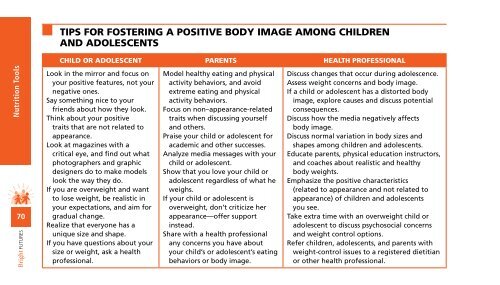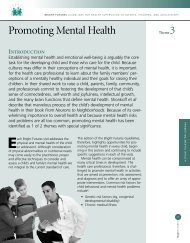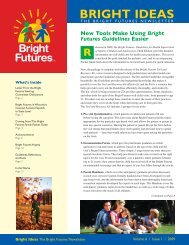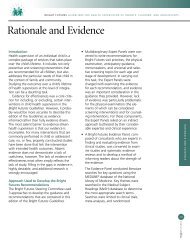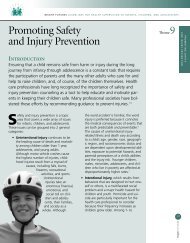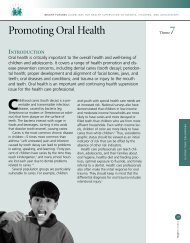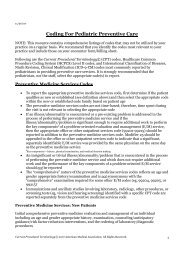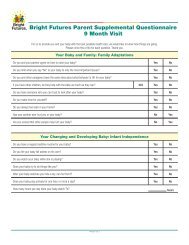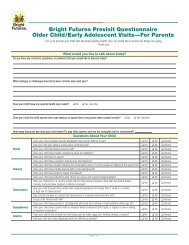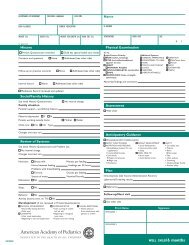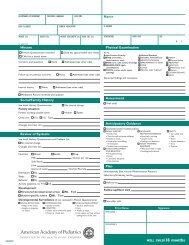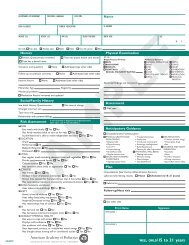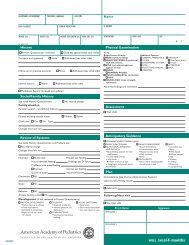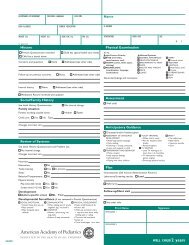POCKET GUIDE - Bright Futures - American Academy of Pediatrics
POCKET GUIDE - Bright Futures - American Academy of Pediatrics
POCKET GUIDE - Bright Futures - American Academy of Pediatrics
Create successful ePaper yourself
Turn your PDF publications into a flip-book with our unique Google optimized e-Paper software.
Nutrition Tools<br />
70<br />
<strong>Bright</strong> FUTURES<br />
■■ TiPs for fosTering a PosiTiVe body image among Children<br />
and adolesCenTs<br />
Child or adolesCenT ParenTs healTh Pr<strong>of</strong>essional<br />
Look in the mirror and focus on<br />
your positive features, not your<br />
negative ones.<br />
Say something nice to your<br />
friends about how they look.<br />
Think about your positive<br />
traits that are not related to<br />
appearance.<br />
Look at magazines with a<br />
critical eye, and find out what<br />
photographers and graphic<br />
designers do to make models<br />
look the way they do.<br />
If you are overweight and want<br />
to lose weight, be realistic in<br />
your expectations, and aim for<br />
gradual change.<br />
Realize that everyone has a<br />
unique size and shape.<br />
If you have questions about your<br />
size or weight, ask a health<br />
pr<strong>of</strong>essional.<br />
Model healthy eating and physical<br />
activity behaviors, and avoid<br />
extreme eating and physical<br />
activity behaviors.<br />
Focus on non–appearance-related<br />
traits when discussing yourself<br />
and others.<br />
Praise your child or adolescent for<br />
academic and other successes.<br />
Analyze media messages with your<br />
child or adolescent.<br />
Show that you love your child or<br />
adolescent regardless <strong>of</strong> what he<br />
weighs.<br />
If your child or adolescent is<br />
overweight, don’t criticize her<br />
appearance—<strong>of</strong>fer support<br />
instead.<br />
Share with a health pr<strong>of</strong>essional<br />
any concerns you have about<br />
your child’s or adolescent’s eating<br />
behaviors or body image.<br />
Discuss changes that occur during adolescence.<br />
Assess weight concerns and body image.<br />
If a child or adolescent has a distorted body<br />
image, explore causes and discuss potential<br />
consequences.<br />
Discuss how the media negatively affects<br />
body image.<br />
Discuss normal variation in body sizes and<br />
shapes among children and adolescents.<br />
Educate parents, physical education instructors,<br />
and coaches about realistic and healthy<br />
body weights.<br />
Emphasize the positive characteristics<br />
(related to appearance and not related to<br />
appearance) <strong>of</strong> children and adolescents<br />
you see.<br />
Take extra time with an overweight child or<br />
adolescent to discuss psychosocial concerns<br />
and weight control options.<br />
Refer children, adolescents, and parents with<br />
weight-control issues to a registered dietitian<br />
or other health pr<strong>of</strong>essional.


